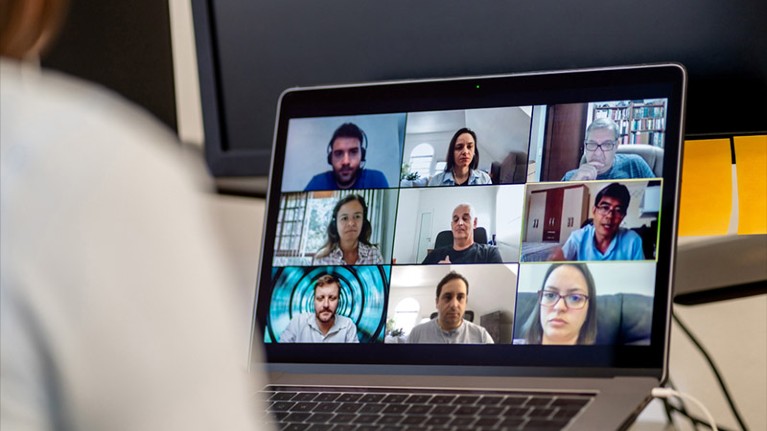Research teams spread across long distances are less likely to achieve ‘disruptive’ discoveries than those based in one place.Credit: Gabriel Pevide/Getty
Working in remote teams can hurt innovation, according to a study1 that suggests that researchers based at the same site make more breakthrough discoveries. Remote collaborators can benefit from greater collective knowledge, the research points out, but because such teams don’t integrate fully, they are less likely to engage in conceptual tasks. That makes them better suited to make only incremental progress at the expense of disruptive discoveries.
“People that collaborate at distance are less likely to come up with these more foundational types of discoveries,” says Carl Frey, an economist at the University of Oxford, UK, and study co-author. “The breakthroughs that are being made are more likely to be made by people that are more geographically proximate.”
What kind of breakthroughs? Frey points to the technological leap that moved transportation from the horse and cart to the automobile. That’s the type of jump forward that experts predicted would happen with remote collaboration because it allows researchers to connect with dispersed teams.
“And yet that is not what we’re really seeing,” he says. “We see research productivity has been in decline, and we’ve seen some evidence2 that breakthrough innovation has been in decline as well.” The results were published today in Nature.
Disruption and distance
To assess the output of research teams, the study analysed 20 million research articles published between 1960 and 2020, and 4 million patent applications submitted between 1976 and 2020 around the globe. The researchers looked at the affiliations and geographic range of authors and patent contributors. They also used a form of citation analysis called the D score to assess publications according to how ‘disruptive’ they proved to be.
The D score runs from -1 to 1, with 1 being the most disruptive. It assumes that a paper is more disruptive if subsequent work cites it, but not the studies that the original paper builds on. By contrast, a paper cited along with its own foundational studies is classed as incremental and so less disruptive. This technique scores, for example, the 1953 paper3 on the structure of DNA, by US molecular biologist James Watson and UK molecular biologist Francis Crick, as among the most disruptive works in the team’s data set, and the 2001 paper4 on the human genome by the International Human Genome Sequencing Consortium as among the least.
Papers that proposed scientific concepts (such as the time-evolving block decimation, an algorithm used to simulate quantum systems) and patents that introduced technologies (such as web crawling) were also scored as more radically innovative.
The green and red dots represent cities that are more and less likely, respectively, to produce disruptive science. The coloured lines symbolize the flow of information between cities; 70% of the lines are red to denote that 70% of city pairs are home to teams that produce non-disruptive outputs.Credit: Yiling Lin
The team found that, over the past 50 years, the average distance between members of a team increased from 100 kilometres to nearly 1,000 kilometres for a paper, and from 250 kilometres to 750 kilometres for a patent. And the fraction of extremely long-distance collaborations — of more than 2,500 kilometres — increased from 2% to 15% for papers, and from 3% to 9% for patents.
But such dispersion came with a penalty, with remote teams making fewer breakthroughs. When increasing collaboration distance from 0 kilometres to more than 600 kilometres, the probability of disruption — defined as a D score greater than zero — fell from 28% to 22% for papers, and 67% to 55% for patents.
Marina Schröeder, an innovation economist at Leibniz University Hannover in Germany, who has looked5 at the effects of remote working on creativity, says that the study is the first to so clearly distinguish between the different outputs from co-located and remote teams.
“It shows what intuitively we all thought: that one size does not fit all when talking about working from home,” she says. “There can be side effects of moving towards remote work.”
Exactly why and how remote teams produce less disruptive research needs more research, Frey says.
“It probably has to do something with the intensity,” he says. “And the fact that, when something is tacit and when an idea isn’t quite crisp yet, it’s actually quite hard to communicate.”
